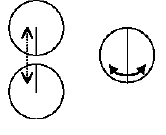Mixing Colours
Solve problems involving ratios.
Number Framework Stage 8
Using Materials
Ask the students if they know about the primary colours, red, yellow, and blue. Tell them that mixing the primary colours can create other colours. This can be demonstrated by mixing yellow and blue acrylic paint to get green.
Problem: “Picasso has three recipes for mixing green paint. They are:
A: One part of blue with three parts of yellow (1:3)
B: Four parts of blue with eight parts of yellow (4:8)
C: Three parts of blue with five parts of yellow (3:5)
Which recipe will give him the darkest shade of green?” (It is the relative quantity of blue to yellow that makes the green darker.)
Get the students to build Unifix cube or beans models of the three recipes:
Ask the students how the different ratios could be compared. Their responses might
include:
(i) Relating the recipes to equivalent fractions, e.g., 1:3 is the same as 1/4 , 4:8 is the same as 4/12 = 1/3 , 3:5 is the same as 3/8 .
(ii) Equalising the lengths of the cube models by building up or breaking down, for example, 1:3 makes up to 6:18 (six times), which is a smaller ratio than 4:8, which makes up to 8:16 (two times). Both stacks have 24 cubes.
(iii) Mapping one of blue onto so many yellows, for example, 3:5 means that one blue is mapped onto one and two-thirds yellows (1:1 2/3), 4:8 means that one blue is mapped to two yellows (1:2).
Considering method (ii), the students might make duplicates of the recipes until the lengths are equalised. The yellows and blues are then collected so that the ratios can be compared.
This is easily drawn on a double number line:
Challenge the students to represent each ratio using the rotating region. This provides an excellent link to percentages as each circle has one hundred divisions around its circumference.
These circles can be rotated to show any two fractions that add to one. Pose similar problems for the students to explore using cubes or beans.
Recipes for orange:
X: 3 parts red to 7 parts yellow (3:7 or 3/10)
Y: 5 parts red to 15 parts yellow (5:15 or 5/20)
Z: 1 parts red to 4 parts yellow (1:4 or 1/5)
“Which recipe gives the darkest orange?” (It is the relative quantity of red to yellow that makes the colour darker.)
Using Imaging
Shielding: Pose problems that make comparison easy. For each recipe, make a stack with cubes. Trace around each length of cubes and mark and shade the colour break.
Ensure that the ratios are recorded so that the students can refer to them.
Problem: Recipe for purple:
P: 6 parts red with 14 parts blue
Q: 4 parts red with 6 parts blue
R: 7 parts red with 8 parts blue
“Which recipe gives the darkest purple?” (It is the relative quantity of blue to red that makes the colour darker.)
Using Number Properties
Pose problems of ratio comparison using only numbers. Record these problems using symbols:
“Which blue-to-yellow ratio gives a darker shade of green?
2:5 or 3:4 7:15 or 3:6 1:4 or 18:80 4:7 or 9:18 7:8 or 8:9”
(Note: Once again, it is the quantity of blue that determines the darkness of the colour.)
The students will need to consider these ratios as proportions, for example, 2:5 is equivalent to 2/7.



